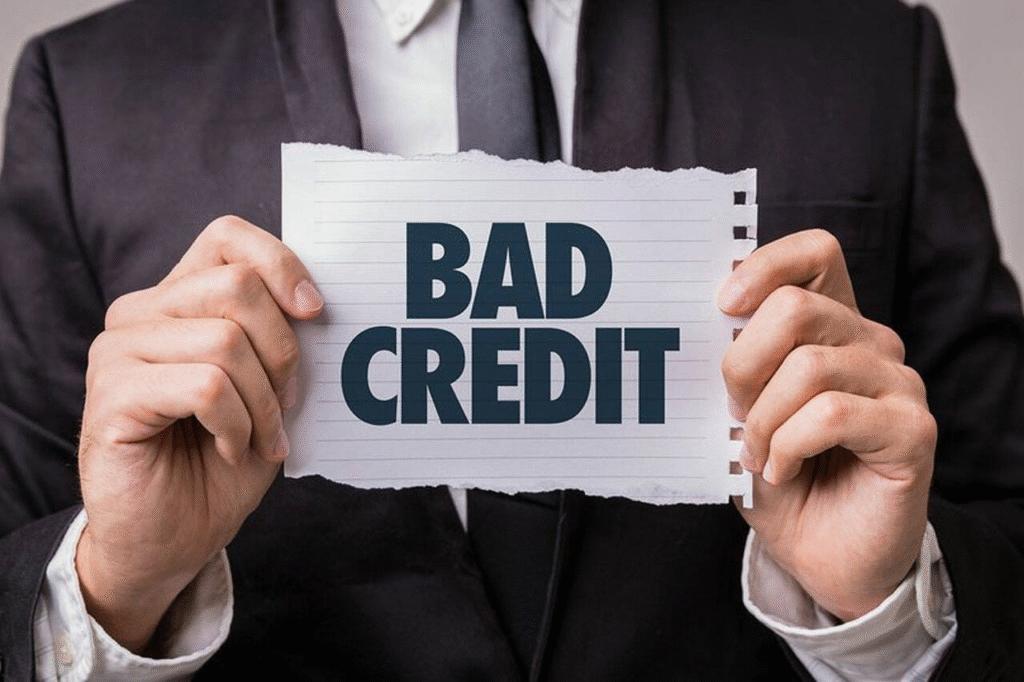In 2025, securing a personal loan with a bad credit score remains challenging but increasingly feasible, thanks to evolving lending practices and alternative financing options. While traditional banks often rely heavily on credit scores, a growing number of lenders are adopting more flexible criteria, focusing on factors such as income stability, employment history, and the presence of collateral. This shift is particularly beneficial for individuals with poor credit histories who may have previously struggled to obtain financing.
Key Takeaways
Employment Stability: A steady income stream is crucial for loan approval.
Alternative Lenders: NBFCs and P2P platforms offer more flexible lending criteria.
Secured Loans: Providing collateral can enhance loan approval chances.
Co-Applicants: A co-applicant with a strong credit profile can improve eligibility.
Documentation: Complete and accurate documentation can compensate for a low credit score.
Understanding Bad Credit in 2025

A “bad” credit score typically refers to a CIBIL score below 600 in India. Such a score indicates a history of missed payments, defaults, or high credit utilization, which can make lenders hesitant. However, it’s important to note that credit scores are not the sole determinant in loan approval processes. Lenders are increasingly considering a holistic view of a borrower’s financial situation.
How to Secure a Personal Loan with Bad Credit
1. Explore Non-Banking Financial Companies (NBFCs)
NBFCs are more inclined to approve loans based on income and repayment capacity rather than solely on credit scores. In 2024, approvals for low-CIBIL borrowers rose by 30%, with fintechs leading the charge. While interest rates may be higher, often ranging from 12% to 18%, the approval process is typically faster, sometimes within 24–48 hours.
2. Consider Secured Loans
What Is a Secured Loan?
A secured loan is a type of loan backed by collateral — an asset you own that the lender can claim if you default. This lowers risk for the lender and usually means:
- Lower interest rates
- Higher borrowing limits
- Longer repayment terms
Common Types of Secured Loans
| Type | Collateral Required | Typical Use |
|---|---|---|
| Mortgage | Real estate | Buying a home |
| Auto Loan | The car itself | Buying a vehicle |
| Home Equity Loan | Your home’s equity | Renovations, debt consolidation |
| Secured Personal Loan | Savings, CD, car, etc. | Medical bills, large purchases |
| Business Loan | Equipment, inventory, property | Starting or expanding a business |
Pros of Secured Loans
- Lower interest rates than unsecured loans
- Easier approval for borrowers with lower credit scores
- Access to larger loan amounts
- Longer repayment terms, reducing monthly payments
Cons and Risks
- Risk of losing your asset if you default
- Longer application process due to asset verification
- Market fluctuations can reduce your collateral value (especially property)
What You’ll Need to Apply
- Proof of identity (ID, SSN, etc.)
- Proof of income (pay stubs, tax returns)
- Credit report
- Asset documentation (title, deed, appraisal)
- Loan purpose (in some cases)
Key Things to Compare
When shopping for secured loans, compare:
| Factor | What to Look For |
|---|---|
| Interest rate | Fixed or variable, APR |
| Loan term | Monthly payment vs. total cost |
| Fees | Origination, appraisal, penalties |
| Lender reputation | Reviews, licensing, support |
| Loan-to-value ratio | Max % of collateral you can borrow |
Use Secured Loans Strategically
Explore alternatives like 0% balance transfers, unsecured personal loans, or credit union options if the risk to your asset is too high.
Consider secured loans only if you’re confident in your ability to repay.
Use them to build credit, refinance expensive debt, or fund major needs (not wants).
3. Apply with a Co-Applicant
Including a co-applicant with a strong credit score and stable income can enhance your loan eligibility. In 2024, 40% of joint loans for bad credit were approved, demonstrating the positive impact of a co-applicant.
4. Highlight Job Stability
In a Loan or Credit Application
Why it matters: Lenders look for job stability to assess your ability to make consistent payments.
How to Highlight:
- Length of employment: “I have been employed with [Company Name] for over 5 years.”
- Position consistency: “Held the same role or progressed steadily within the same company.”
- Income regularity: “Consistent monthly income for the past [X] years.”
Example Statement:
“I have been a full-time [Position Title] at [Company Name] since 2018, demonstrating consistent employment and a reliable income history.”
On a Résumé or CV
Why it matters: Shows reliability, loyalty, and potential for long-term contribution.
How to Highlight:
- Use bullet points like:
- “Promoted within the company after 3 years of successful performance.”
- “Maintained continuous employment at [Company Name] since 2017.”
- Emphasize tenure in job title formatting:
- Senior Analyst | XYZ Corp | 2016–Present
In a Cover Letter
Why it matters: Helps build credibility and trust with employers or lenders.
Example Sentence:
“My five-year tenure at [Company Name] reflects both my dedication to professional growth and the stability I bring to any team or responsibility.”
In a Job Interview
Why it matters: Employers want to know you’re not job-hopping.
How to Emphasize:
- Talk about long-term goals within a company
- Explain any transitions positively (e.g., for career growth)
5. Opt for Peer-to-Peer (P2P) Lending
P2P lending platforms connect borrowers directly with individual investors, bypassing traditional financial institutions. These platforms may offer more flexible lending criteria and are increasingly popular among those with bad credit.
6. Provide Comprehensive Documentation
Submitting complete and accurate documentation can facilitate the loan approval process. Essential documents include identity proof, income statements, bank statements, and proof of residence. Thorough documentation can compensate for a low credit score by demonstrating financial responsibility.
Understanding Bad Credit in 2025
A “bad” credit score typically refers to a CIBIL score below 600 in India. Such a score indicates a history of missed payments, defaults, or high credit utilization, which can make lenders hesitant. However, it’s important to note that credit scores are not the sole determinant in loan approval processes. Lenders are increasingly considering a holistic view of a borrower’s financial situation.
How to Secure a Personal Loan with Bad Credit
1. Explore Non-Banking Financial Companies (NBFCs)
NBFCs are more inclined to approve loans based on income and repayment capacity rather than solely on credit scores. In 2024, approvals for low-CIBIL borrowers rose by 30%, with fintechs leading the charge. While interest rates may be higher, often ranging from 12% to 18%, the approval process is typically faster, sometimes within 24–48 hours.
2. Consider Secured Loans
Offering collateral, such as gold, property, or term deposits, can significantly improve your chances of loan approval. Secured loans carry lower risk for lenders, which may result in more favorable terms. For instance, loans against gold jewelry can be approved with minimal documentation and no credit score check.
3. Apply with a Co-Applicant
Including a co-applicant with a strong credit score and stable income can enhance your loan eligibility. In 2024, 40% of joint loans for bad credit were approved, demonstrating the positive impact of a co-applicant.
4. Highlight Job Stability

Lenders often prioritize employment stability over credit scores. Individuals employed in government sectors or reputable private companies are more likely to secure loans, even with poor credit histories. Providing proof of employment and a steady income stream can bolster your application.
5. Opt for Peer-to-Peer (P2P) Lending
P2P lending platforms connect borrowers directly with individual investors, bypassing traditional financial institutions. These platforms may offer more flexible lending criteria and are increasingly popular among those with bad credit.
6. Provide Comprehensive Documentation
Submitting complete and accurate documentation can facilitate the loan approval process. Essential documents include identity proof, income statements, bank statements, and proof of residence. Thorough documentation can compensate for a low credit score by demonstrating financial responsibility.
Also Read :-What Are the Key Factors That Determine Your Loan Eligibility?
Conclusion
Securing a personal loan with bad credit in 2025 is challenging but achievable. By exploring alternative lenders, considering secured loan options, and providing comprehensive documentation, individuals with poor credit histories can improve their chances of loan approval. It’s essential to assess your financial situation, understand the terms and conditions of the loan, and ensure that you can meet repayment obligations to avoid further financial strain.
Frequently Asked Questions (FAQs)
1. Can I get a personal loan with a CIBIL score below 600?
Yes, while challenging, it’s possible through NBFCs, secured loans, or by applying with a co-applicant.
2. What is the typical interest rate for loans with bad credit?
Interest rates can range from 12% to 18%, depending on the lender and loan type.
3. How can a co-applicant improve my loan application?
A co-applicant with a strong credit score and stable income can enhance your eligibility and potentially secure better loan terms.
4. Are there any government schemes for individuals with bad credit?
While specific schemes may vary, some government-backed programs aim to provide financial assistance to individuals with poor credit histories.
5. How long does it take to get a loan with bad credit?
Approval times can vary; however, some lenders offer fast-track processes, with funds disbursed within 24–48 hours.
6. Can I improve my credit score before applying for a loan?
Yes, improving your credit score by paying off existing debts and maintaining timely payments can enhance your loan eligibility.
7. Are there any risks associated with loans for bad credit?
Yes, higher interest rates and the potential for increased debt are risks. It’s crucial to assess your repayment capacity before proceeding.
